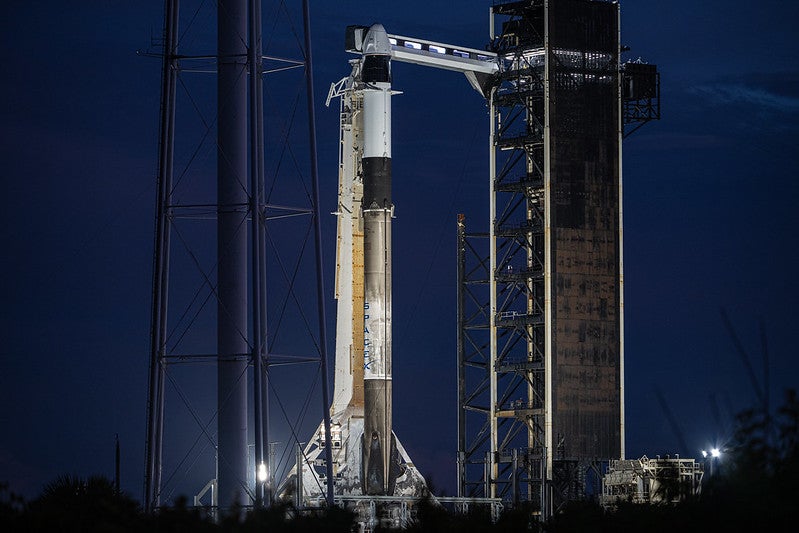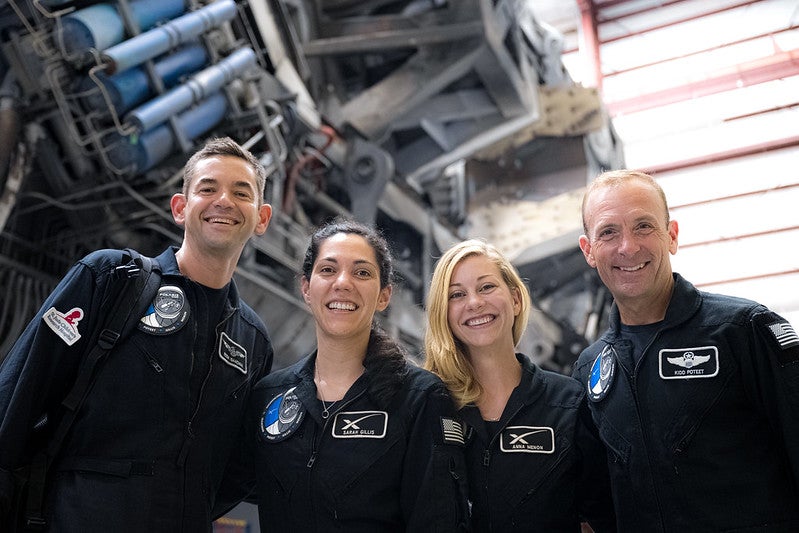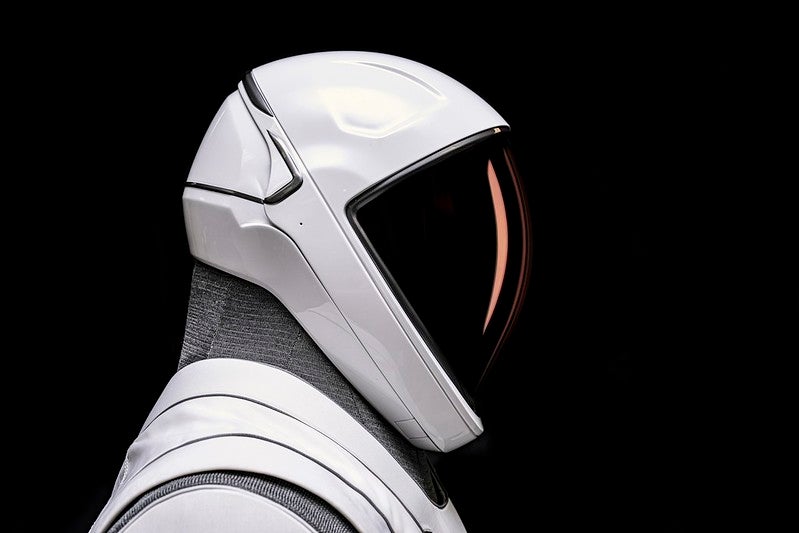
A billionaire entrepreneur and aviator, a Thunderbird pilot, a former NASA biomedical flight controller, and an experienced astronaut training program lead are preparing to launch atop a SpaceX Falcon 9 rocket from Florida’s Kennedy Space Center early Tuesday. Over five days, the trailblazing Polaris Dawn crew will conduct 36 experiments, make the first commercial spacewalk, fly higher than any humans in five decades, and conduct health research from within Earth’s Van Allen radiation belts.
The crew will reach 870 miles (1,400 kilometers) — higher than any Earth-orbiting human mission in history — aboard SpaceX’s Dragon Resilience capsule. It is the first of two private missions comprising the Polaris Program, announced in February 2022 by billionaire Jared Isaacman and SpaceX “to rapidly advance human spaceflight capabilities.”
Originally scheduled for November 2022, the development of SpaceX’s EVA suit delayed the mission nearly a year. The partial failure of a Falcon 9 launch last month added further complications. Liftoff is now scheduled from Pad 39A on Tuesday at one of three possible times: 3:38 A.M., 5:23 A.M., or 7:09 A.M. EDT.
Meet the crew
Commander Jared “Rook” Isaacman founded the Shift4 payments firm as a teenager. An accomplished aviator, in 2009 he circumnavigated the globe in 61 hours. And in 2021, Isaacman commanded Inspiration4, the first all-civilian spaceflight, whose crew featured the first astronaut with a prosthesis and raised $250 million for St. Jude’s Children’s Research Hospital.
Pilot Scott “Kidd” Poteet, a retired Air Force fighter pilot and combat veteran, graduated from Air Force Weapons School and as a Thunderbird flew with Britain’s famed Red Arrows. Poteet previously served as Inspiration4 mission director.
Joining Isaacman and Poteet are two mission specialists: SpaceX engineers Anna Menon and Sarah Gillis. A former International Space Station (ISS) biomedical flight controller before joining SpaceX as a mission director, Menon got hooked on space in fourth grade. Her teacher was Alison Smith Balch, daughter of astronaut Mike Smith, who died in the 1986 Challenger disaster. She is also the mission’s medical officer.
Gillis, too, found inspiration from a school mentor: astronaut Joe Tanner, who encouraged the classical violinist to pursue aerospace engineering. Gillis interned at SpaceX and later, as a space operations engineer, helped train astronauts for flight aboard the Dragon capsule — including the Inspiration4 crew.

Mission of firsts
Gillis and Isaacman’s EVA at a planned 435 miles (700 km) in altitude will seize several world records. Three times higher than the ISS, it will be the highest EVA ever in Earth orbit, smashing an altitude record of 850 miles (1,370 km) set by Gemini 11 astronauts Charles “Pete” Conrad and Richard “Dick” Gordon in September 1966.
Aged 30 years 242 days on the planned date of the EVA, Gillis will also become the youngest human to spacewalk, eclipsing first-ever spacewalker Soviet cosmonaut Alexei Leonov, who was 30 years 292 days old when he floated outside the Voskhod-2 capsule in March 1965.
Jointly with Menon, Gillis will also fly to the highest altitude ever attained by a woman. They will more than double the 358 miles (576 km) reached by astronauts Kathy Thornton, Nancy Currie, and Megan McArthur across three Hubble Space Telescope repair flights between 1993 and 2009.
Humans in space
Polaris Dawn’s orbit will soar through a region called the South Atlantic Anomaly. Here, the lowermost of Earth’s two Van Allen belts, a zone of energetic charged particles extending from 620 to 36,000 miles (1,000 to 58,000 km) above the planet, comes closest to Earth. With high concentrations of electrons and energetic protons, the Van Allen belts are harmful to humans if exposed for prolonged periods. The crew’s expected radiation dosage over just five days in this environment is equivalent to three months aboard the ISS.
Related: The spacecraft-killing anomaly over the South Atlantic
The crew will use radiation monitors and badges to log their received doses. They will investigate mysterious flashes of light astronauts report when their eyes are closed, thought to be caused by cosmic radiation, and explore radiation effects on plant growth.
Another focus is furthering research on the effects of spaceflight on the human body. The crew will investigate the changes in eye shape and vision some astronauts experience, possibly due to fluid shifts toward the head in microgravity, using 3D ultrasound scans and “smart” contact lenses with tiny sensors. They will collect biological samples and test tools for avoiding bone and muscle loss, as well as trial a new anti-nausea medication. And they will attempt to understand the brain’s role in learning and remembering the space environment for repeat trips. Crew members will also evaluate how future deep-space travelers might diagnose and treat themselves with off-the-shelf commercial equipment and test the viability of CPR in space.
Testing the limits
On two prior flights in 2020 and 2021, Resilience accrued 170 days in space, traveled 71 million miles (115 million km) and clocked 2,734 orbits. Isaacman, Poteet, Menon, and Gillis will fly Resilience another 2.1 million miles (3.4 million km) and 80 more orbits.
Upon launch, Polaris Dawn’s initial orbit will carry it to 750 miles (1,200 km) at its highest (apogee) and 120 miles (200 km) at its lowest (perigee). After validating Resilience’s health, the ship’s Draco thrusters will then raise the apogee to 870 miles (1,400 km) — a new world record. Polaris Dawn will retain this apogee for 10 hours on the first day, then lower it to 435 miles (700 km) until mission’s end.
But the flight’s real drama undoubtedly is the spacewalk on day three. Since Resilience has no airlock, the entire capsule will be depressurized to vacuum, with all crew members wearing spacesuits. In preparation, cabin pressure and oxygen levels will be gradually adjusted over 45 hours prior to the spacewalk. This will ensure the astronauts do not suffer decompression sickness (the bends) when shucking their spacesuits afterward, as the suits offer far lower pressure than the normal cabin pressure.

Based on the suit already used by Dragon crews for launch and landing, Polaris Dawn’s suit adds a 3D-printed helmet with a single-layer visor and a heads-up display for suit metrics. It is fireproof with stretchable fabric, redundant seals and pressure valves, novel rotator joints, and boots made from the same heat-retardant material used on the Falcon 9.
To begin the spacewalk, Isaacman will scale a ladder (nicknamed the skywalker) mounted in Resilience’s docking port and open the motor-driven hatch, exposing the entire crew to vacuum. That will break a record for the greatest number of humans simultaneously exposed to space, which dates to May 1992, when Pierre Thuot, Rick Hieb, and Tom Akers made the first (and only) three-man EVA during space shuttle Endeavour’s STS-49 mission.
Connected via umbilical to the capsule’s life-support utilities, Isaacman and Gillis will go outside separately for 15 to 20 minutes each, maintaining contact with the capsule via mobility aids fixed to the skywalker. They will showcase the suit’s thermal and life-support performance and perform a series of test exercises that Isaacman in a tweet likened to a dance.
As the highest EVA in Earth orbit, the risks of micrometeoroid impacts is correspondingly heightened. Resilience will be positioned to shade the hatch from potential impacts, shielding the spacewalkers.
The spacewalk should last two hours, counting time for cabin venting, pressurization, and contingencies. Inside the ship, Poteet and Menon will remain seated, managing the umbilicals and monitoring data.
Much more to accomplish
The remainder of Polaris Dawn is filled with science and public outreach. The crew is carrying a silver bar for use in future Olympic medals and four white ceramic watches donated by Swiss luxury watchmaker IWC Schaffhausen to be auctioned for St. Jude’s Children’s Research Hospital.
Doritos, the mission’s charitable partner, has provided glow-in-the-dark boxes of Cool Ranch Zero Gravity chips with an oil-based coating to prevent crumbling in space. “We appreciate having a solid snack to eat in space,” Isaacman tweeted earlier this month.
On day four, the crew will use Starlink to connect with ground-based doctors for a telemedicine test. Gillis also said during an interview that the crew has “a special message that we will share with the world” via Starlink.
After five days, Resilience will splash down off the coast of Florida.
The Polaris Program attracted media attention in late 2022 when NASA and SpaceX signed an unfunded Space Act Agreement to explore a Dragon mission to boost Hubble into a higher orbit. However, in June it emerged that a Dragon-aided boost of the telescope is no longer being pursued by NASA.
It remains to be seen what future Polaris missions will look like — but first, this one aims to make history.

